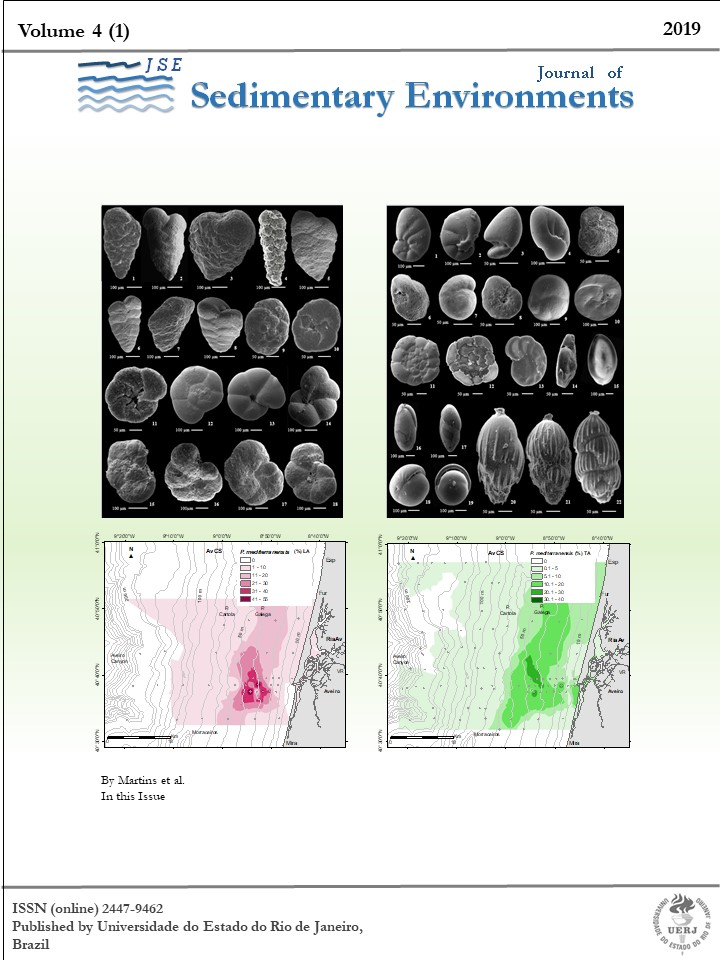OIL PRODUCED WATER TREATMENT USING ADVANCED OXIDATIVE PROCESSES: HETEROGENEOUS-PHOTOCATALYSIS AND PHOTO-FENTON
DOI:
https://doi.org/10.12957/jse.2019.40991Keywords:
Contaminants. Treatment. Oil Produced Water. Seawater. Phenol. Advanced Oxidative Processes (AOPs).Abstract
The Oil Produced Water (OPW) is an effluent produced during the oil extraction process. Owing to its complex composition and toxicity it must be treated by wastewater treatment technologies. However, traditional facilities may be unable to remove all the anthropogenic or naturally occurring compounds. This can result in their discharge to surface water and ultimately affecting the sedimentary environment. The present work shows the application of two Advanced Oxidative Processes (AOPs), Photocatalysis and Photo-Fenton to treat two kinds of effluents: phenolic solution made in seawater, and a real sample of OPW from Rio Grande do Norte, Brazil. Two commercial catalysts were used: TiO2 (for Heterogeneous-Photocatalysis process), and FeSO4.7H2O (for Photo-Fenton process). The catalysts were characterized by X-Ray Diffraction Analysis (XRD), and Diffusive Reflectance Spectroscopy (DRS). In the two AOPs the following parameters were evaluated: initial pH of effluent (acid, neutral and alkaline), presence of H2O2 (0.3%v/v) and time under ultra-violet (UV) irradiation (254nm); aiming to find the suitable conditions for OPW treatment. The results showed an efficiency of 99% for phenol removal, despite the high content of salts present in seawater. In the treatment of the two effluents by the AOPs, the reaction reached chemical equilibrium in 1 h under UV irradiation (254 nm); the best pH to treat the effluents was pH 7, in the presence of H2O2 (0.3%v/v) and by increasing temperature to 75°C (in the case of the real sample of OPW). The results of this work show that the two studied AOPs can be used in the oil industry, for OPW treatment and to treat effluents (with high salinity) contaminated with phenol, to remove organic compounds in order to reduce their toxicity, and consequently assist towards a better quality of the sedimentary environment. The best results were obtained by the Photo-Fenton process.
TÍTULO: TRATAMENTO DE ÁGUA PRODUZIDA DE PETRÓLEO USANDO PROCESSOS OXIDATIVOS AVANÇADOS: FOTOCATÁLISE HETEROGÊNEA E FOTO-FENTON
RESUMO
A Água Produzida por Petróleo (OPW) é um efluente gerado durante o processo de extração de óleo. Devido à sua composição complexa e toxicidade, deve ser tratada por tecnologias de tratamento de águas residuais. No entanto, as instalações tradicionais podem não ser capazes de remover todos os compostos antropogênicos ou de ocorrência natural, podendo resultar na descarga de efluentes contaminados por óleo em águas da superfície e, em última análise, afetar o ambiente sedimentar. O presente trabalho mostra a aplicação de dois Processos Oxidativos Avançados (AOPs), Fotocatálise-Heterogênea e Foto-Fenton para tratar dois tipos de efluentes: solução fenólica em água do mar e uma amostra real de OPW do Rio Grande do Norte, Brasil. Foram utilizados dois catalisadores comerciais: TiO2 (para o processo Fotocatálise Heterogênea) e FeSO4.7H2O (para o processo Foto-Fenton). Os catalisadores foram analisados por Difração de Raios-X (XRD) e Espectroscopia de Reflexão Difusiva (DRS). Nos dois AOPs foram avaliados os seguintes parâmetros: pH inicial do efluente (ácido, neutro e alcalino), presença de H2O2 (0,3% v/v) e tempo sob irradiação ultravioleta (UV) (254nm); com o objetivo de encontrar as condições adequadas para o tratamento de OPW. Os resultados mostraram uma eficiência máxima de 99% na remoção de fenol, apesar do alto teor de sais presentes na água do mar. No tratamento dos dois efluentes pelos AOPs, a reação atingiu o equilíbrio químico em 1 h sob irradiação UV (254 nm); o melhor pH para tratar os efluentes foi pH 7, na presença de H2O2 (0,3% v/v) e aumentando a temperatura para 75 °C (no caso da amostra real de OPW). Os resultados deste trabalho mostram que as duas AOPs estudadas podem ser utilizadas na indústria petrolífera, para tratamento de OPW e para tratar efluentes (com alta salinidade) contaminados com fenol, para remover compostos orgânicos a fim de reduzir a sua toxicidade e, consequentemente, manter a qualidade do ambiente sedimentar. Os melhores resultados foram obtidos pelo processo Foto-Fenton.
PALAVRAS-CHAVE: Contaminantes. Tratamento. Água Produzida de Petróleo. Água marinha. Fotocatálise Heterogênea. Foto-Fenton. Processos Oxidativos Avançados (AOPs).
Downloads
Published
Issue
Section
License

Journal of Sedimentary Environments (JSE) is licensed under a Creative Commons Attribution-Noncommercial-Share Alike 4.0 International License.

